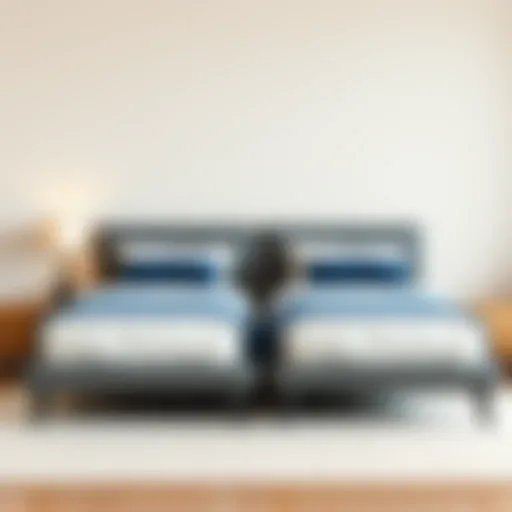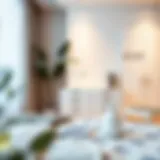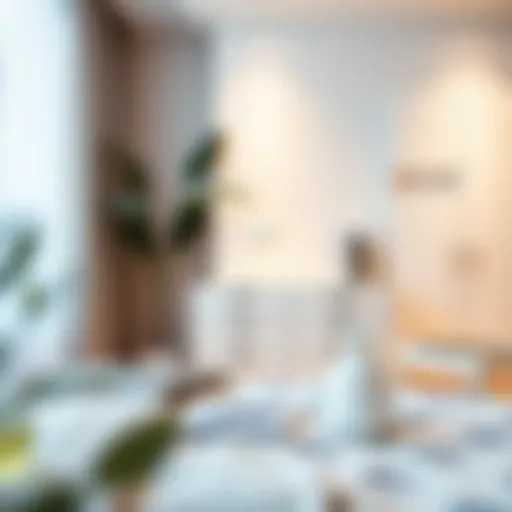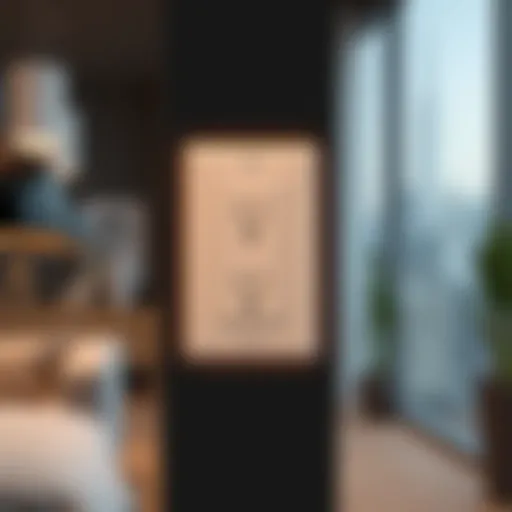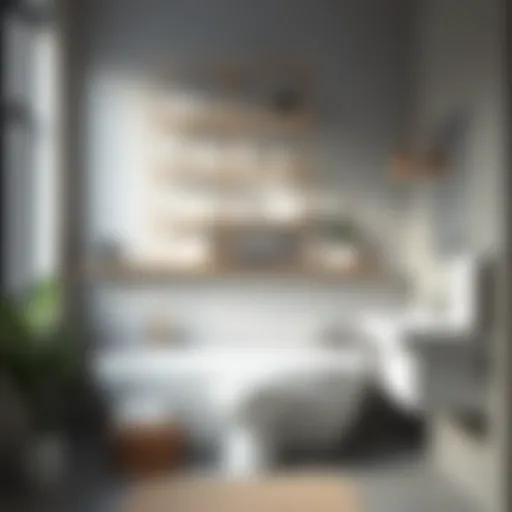Exploring Shelf Clamps in Contemporary Furniture Design
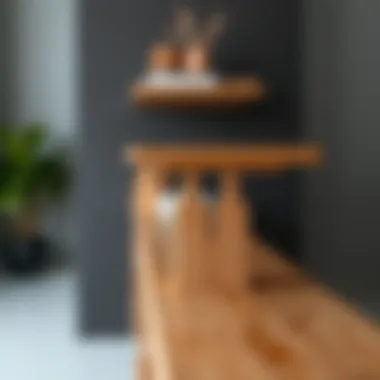
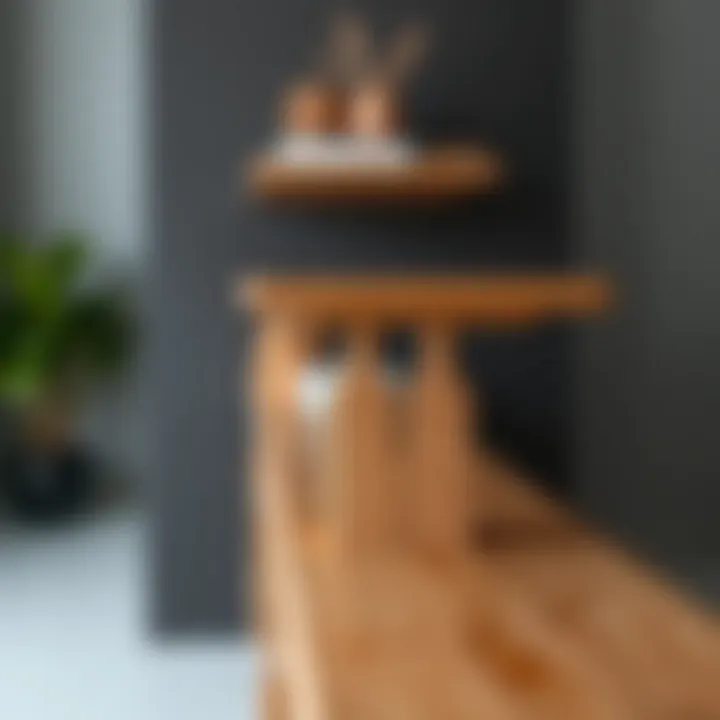
Intro
In the realm of modern furniture design, the integration of functionality with aesthetic appeal is paramount. Among the unsung heroes facilitating this synergy are shelf clamps. Often overlooked, these compact devices play an essential role in ensuring furniture stability and visual cohesion across various spaces.
Contrary to mere support components, shelf clamps embody the spirit of contemporary design, evolving in shape, size, and function to meet the demands of both residential and commercial environments. This article aims to shed light on the myriad types of shelf clamps available, their versatile applications, installation techniques, and the ever-changing design philosophies that shape their usage today.
Design Trends
In the landscape of furniture, design trends dramatically shift, influenced by evolving tastes, technology, and artistic movements. Shelf clamps, though small, are vital in reflecting these design inclinations, demonstrating that even the smallest parts can contribute significantly to modern aesthetics and functionality.
Contemporary Styles
Today’s furniture styles emphasize minimalism, functionality, and rugged elegance. These themes lead to the creation of floating shelves, where shelf clamps provide an unseen, sturdy foundation. The use of materials such as metal and high-density plastics has revolutionized the shelf clamp design, allowing for a more sleek and refined look.
The rise in popularity of open shelving systems, especially in kitchens and living spaces, underscores the necessity of efficient and sturdy clamps. For instance, designs that embrace industrial elements can make use of exposed metal clamps, not just as functional hardware, but as integral to the overall aesthetic.
Color Palettes and Materials
The variety of color palettes and materials used in contemporary furniture directly influences the design of shelf clamps. Traditional metallic finishes have given way to powder-coated options in vibrant hues or subtle tones that can blend seamlessly with their surroundings.
Materials like oak veneer or premium plywood paired with acrylic clamps provide not just stability, but an elegant contrast, making the clamp an unexpected feature of the design. This adaptability in choice enables designers to customize their work, achieving unique finishes that reflect personal styles while maintaining structural integrity.
Functional Solutions
In addition to contributing to aesthetic values, shelf clamps address various functional needs, proving that their importance in modern furniture design runs deeper than mere appearance.
Ergonomic Furniture
The modern consumer leans toward ergonomic solutions, and shelf clamps support this trend by enabling the design of multifunctional furniture. Whether it’s a floating desk or an artfully positioned shelving unit, clamps allow for thoughtful placement that considers user interaction.
For example, shelf clamps can support heavier items without compromising the design concept, creating a sense of openness and accessibility in spaces.
Space Optimization Tips
In today’s ever-shrinking living environments, shelf clamps are invaluable. They facilitate vertical storage solutions, allowing for optimal use of wall space.
- Consider floating shelves to draw the eye upward, making spaces feel larger and more open.
- Install adjustable shelving systems with flexible clamps to cater to changing needs and enhance usability.
- Use clamps designed for corner shelving to maximize otherwise wasted space.
"Effective design marries function with aesthetics, making shelf clamps a critical element in today’s tailored environments."
By understanding the role of shelf clamps in design, interior designers and architects can inspire their clientele with creative, functional solutions that stand the test of time.
Intro to Shelf Clamps
In the realm of modern furniture design, the significance of shelf clamps cannot be overstated. These unassuming yet pivotal components provide both structural support and aesthetic enhancement, bridging the gap between functionality and style. As spaces evolve and the need for efficient storage grows, understanding the role of shelf clamps becomes crucial for designers, architects, and manufacturers alike.
Definition of Shelf Clamps
Shelf clamps can be defined as specialized hardware used to secure shelves to walls or other structural elements. Their primary purpose is to ensure that shelves remain stable under various loads, preventing sagging or displacement. Available in numerous designs and materials, shelf clamps cater to diverse aesthetic preferences and functional needs. Simply put, they are the unsung heroes behind every sleek and organized shelf arrangement.
Historical Context and Evolution
Tracing the roots of shelf clamps reveals a tapestry woven with innovation and necessity. Initially, in the earlier decades, simple wooden dowels and brackets were employed in furniture making. These rudimentary solutions laid the groundwork for more advanced designs. As the century progressed, the introduction of metals and plastics transformed furniture stability and design flexibility. In contemporary times, the evolution continues with smart technology and eco-friendly materials entering the fray, reflecting changing consumer preferences and sustainability concerns.
"The journey of shelf clamps illustrates not just innovation in design but also the changing needs of the environments they help create."
Through this lens, one can appreciate that shelf clamps are not merely functional objects; they are an integral part of the dialogue surrounding modern interior design.
Types of Shelf Clamps
Shelf clamps are not merely utilitarian hardware; they serve as the backbone of design integrity in furniture construction. In this section, we will explore the various types of shelf clamps, each tailored to meet specific needs and requirements. Understanding these distinctions is key for interior designers, architects, and retailers who aim to integrate functionality with aesthetic appeal in their projects.
Fixed Shelf Clamps
Fixed shelf clamps are true workhorses in the shelving world. Typically made from sturdy materials such as stainless steel or heavy-duty plastic, these clamps provide a permanent solution to shelf stability. When installed, they secure the shelves at a predetermined height, ensuring they remain steadfast even under significant weight. One of the appealing aspects of fixed shelf clamps is their straightforward installation. Designers appreciate how uncomplicated it is to install them without specialized tools, making them a favorite choice for both seasoned professionals and DIY enthusiasts alike.
Fixed shelf clamps are an assurance of stability; once they're in place, they're not going anywhere.
These clamps work well for applications that require long-lasting shelf support, such as in libraries or kitchens where books or cookware can be imposing in weight. However, it’s essential to consider that their fixed nature offers no flexibility for height adjustment, which could be a limitation for dynamic spaces.
Adjustable Shelf Clamps
In contrast, adjustable shelf clamps offer flexibility that fixed clamps simply can’t match. Designers often gravitate towards these clamps when they anticipate changes in shelving arrangements or when they need to cater to various display items. Adjustable clamps allow users to reposition their shelves to different heights without significant effort.
These clamps are commonly found in retail spaces where products frequently change. The ability to easily shift shelves up or down means retailers can maintain an ever-evolving aesthetic, which is crucial in attracting customers and keeping the display fresh.
The versatility in design often comes with multiple adjustment holes or sliders, allowing for a smooth transition from one shelf height to another. Nevertheless, it's crucial to evaluate their weight capacity, as this can vary significantly based on the model. While they bring adaptability, sometimes the trade-off can be a compromise in sheer sturdiness compared to their fixed counterparts.
L-brackets and Their Variants
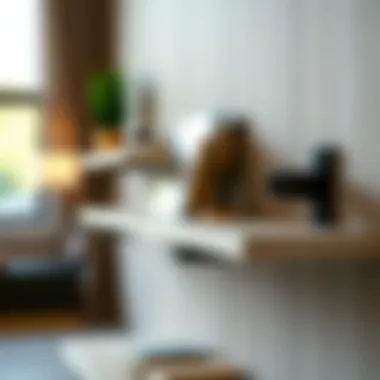

L-brackets represent a unique approach to shelving support. While they might not fit the traditional definition of a clamp, they function effectively as shelf supports by securing shelves to walls or other surfaces at an angle. Their designs are often minimalistic, appealing to those who prefer a clean aesthetic.
These brackets come in various forms: some feature pre-drilled holes for easy installation, while others have reinforced designs to handle heavier loads. One of the key benefits of L-brackets is their compatibility with diverse materials such as wood, metal, or even glass shelves.
However, one must be cautious about visible hardware; depending on the design, they may not fully conceal their mounting fixtures, which can be a concern for those striving for a seamless look.
Specialty Shelf Clamps
Specialty shelf clamps push the boundaries of conventional shelving solutions. These can include clamps designed for specific environments, such as outdoor settings where moisture could compromise standard materials. Other variants might cater to display needs in art galleries or museums, where the preservation of delicate items is paramount.
For instance, some specialty clamps might incorporate soft coatings to protect surfaces from scratches, a significant consideration for valuable art pieces. Others may even integrate locking mechanisms, ensuring that shelves remain securely in place while simultaneously allowing for easy access.
When selecting specialty clamps, understanding the intended use case is paramount. They often come with higher price points but provide specific benefits that can justify the investment, especially in bespoke design projects or environments with unique challenges.
By exploring these various types of shelf clamps, designers and architects can better align their choices with the functional demands of their projects while maintaining a stylish appeal that resonates with users.
Applications of Shelf Clamps
Shelf clamps have diverse applications across various settings, significantly enhancing the functionality and aesthetics of furniture designs. Whether in a cozy home or a bustling commercial environment, the importance of shelf clamps cannot be overstated. They offer stability, versatility, and aesthetic appeal, which make them a foundational component in modern furniture construction. Their adaptability to different uses contributes greatly to their relevance in the design landscape, ensuring that both architects and interior designers look favorably upon them.
Residential Use
In residential spaces, shelf clamps play a crucial role in optimizing storage and organization. The right use of these clamps can turn an ordinary wall into an impressive display or a cluttered room into a tidy space. Let's delve deeper into specific applications within residential settings.
Storage Solutions
Storage solutions are where shelf clamps truly shine. With the increasing trend towards minimalism and efficient use of space, homeowners often find themselves in need of creative storage options. Shelf clamps allow for the installation of floating shelves that provide storage without occupying floor space. One standout characteristic of these configurations is their sleek, unobtrusive design which harmonizes with various decor styles.
The unique feature here is the ability to customize the height and spacing of shelves based on individual needs, making them a popular choice for apartments and homes alike. While they maximize utility, one disadvantage might be the necessity of ensuring proper wall support, as improper installation can lead to sagging or, worse, accidents. Therefore, acknowledging the load-bearing limits of shelf clamps during planning and installation becomes essential to guarantee safety and functionality.
Display Units
In the realm of display units, shelf clamps contribute to the aesthetic interest of a space. By allowing the installation of shelves that projected visually appealing arrangements for items, such as books, plants, or art, they help create focal points in rooms. A key characteristic of display units that utilize shelf clamps is their ability to offer flexibility; they can easily be repositioned or removed, accommodating changing tastes and needs.
This adaptability often makes display units using shelf clamps a favored choice among designers. A potential downside to consider is that if not chosen and installed carefully, some designs might visually clutter a space rather than enhance it. Proper planning and consideration of design elements can mitigate this risk and ensure a visually appealing outcome.
Custom Shelving
Custom shelving options offer homeowners an excellent way to tailor solutions according to individual preferences and space constraints. The customized approach allows for unique shelf configurations to suit specific needs, such as odd-shaped rooms or items that require special dimensions. The standout feature here is the personalization aspect; homeowners can create specialized solutions that align perfectly with their style preferences and functional requirements.
This tailored solution is a much-appreciated choice for its ability to blend functionality with personal expression. However, the downside could be the higher cost associated with custom designs and the potential longer wait time for production compared to standard pre-made options. Proper budgeting and planning beforehand can help in achieving a balance between customizability and practicality.
Commercial Use
Shelf clamps are equally important in commercial environments. They facilitate the smooth operation of retail or office spaces by providing practical solutions that combine functionality and style. Let's explore specific applications where shelf clamps enhance commercial designs.
Retail Displays
Retail displays utilize shelf clamps to create eye-catching layouts that attract customers. These displays leverage the lightweight construction offered by clamps to support various merchandise, making it easier for store owners to showcase products effectively. A notable characteristic here is that they provide an open, airy feel to displays, encouraging customers to browse freely.
The flexibility of arrangement is a significant advantage, allowing retailers to frequently update displays according to trends or seasonal changes. On the flip side, if poorly designed, retail displays can lack cohesion, resulting in an overwhelming visual experience for shoppers. Thus, careful design consideration is essential.
Office Furniture
In offices, shelf clamps prove invaluable in creating organized and functional work environments. By supporting shelving systems that keep documents and supplies orderly, they contribute to a streamlined approach to office furniture. The practicality of shelves clamped securely on walls aids in maximizing floor space, a critical aspect when dealing with often limited office layouts.
One noteworthy characteristic is the ease of installation and adjustment, allowing businesses to adapt shelving as needs change. Nonetheless, some office environments may prefer traditional furniture units that provide more substantial privacy or material aesthetics, creating a need to balance the use of clamps with other furniture elements.
Hospitality Solutions
Lastly, in hospitality, where first impressions matter, shelf clamps help create inviting atmospheres through thoughtfully designed shelving. They enable the creation of shelving units that can be used for showcasing decor, seasonal promotions, or even guest services materials. The unique feature here is their ability to easily blend into different decorative themes—be it rustic, modern, or eclectic.
This adaptability allows hospitality venues to customize their displays according to the vibe they wish to emanate. On the downside, if not properly executed, these displays may not hold up well to wear and tear, especially in high-traffic areas, potentially challenging the durability expectations that guests might have. A thorough understanding of the material strengths and aesthetics will help mitigate these concerns, ensuring a lasting impact.
Materials and Design Considerations
In the realm of modern furniture design, materials and design aesthetics are pivotal. They not only influence the structural integrity of the shelves but also play a crucial role in defining the overall look and feel of a space. When selecting materials for shelf clamps, designers must consider factors such as durability, weight capacity, and compatibility with various finishes. Moreover, the aesthetics of the clamps themselves should harmonize with the furniture they support, ensuring a seamless integration into the design ethos. Each material brings its unique set of characteristics, advantages, and potential drawbacks to the table. Therefore, understanding these is key to crafting functional and visually appealing furniture.
Common Materials Used
Metal

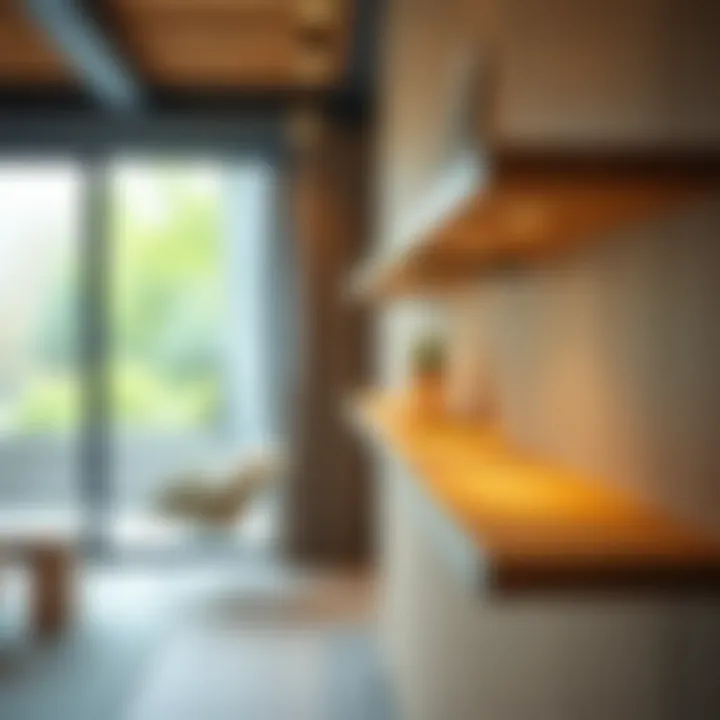
Metal is a hallmark in the construction of shelf clamps, known for its strength and resilience. Steel and aluminum are the primary metals used, with steel being particularly favored for its high tensile strength and durability. This makes it a robust choice capable of supporting significant weight, making it ideal for both residential shelving and commercial display units.
One standout feature of metal shelf clamps is their resistance to wear and corrosion, particularly when treated with finish such as powder coating. This characteristic not only extends the life of the clamps but also adds to their aesthetic versatility. However, one drawback can be their weight; while beneficial for sturdiness, it can sometimes be a challenge during installation or in applications where lightweight materials may be preferred.
Wood
Wood offers a warm, organic appeal that few materials can match, making it a popular option among designers looking to create inviting spaces. Various wood types, such as oak, maple, and birch, are commonly used, each imparting a distinct character to the clamp. A key advantage of wood is its ability to blend with surrounding environments, enhancing the overall aesthetic of the furniture.
Notably, wooden clamps can be finished with varnishes or stains, providing an opportunity for customization and uniqueness. However, wood may not match the strength of metals, particularly for heavy-duty applications. It can also be susceptible to moisture and warping over time, which designers must consider when selecting materials for specific environments.
Plastic
Plastic has made inroads into the market, primarily due to its lightweight and cost-effective nature. Shelf clamps made from high-quality plastics, such as polypropylene or polycarbonate, are surprisingly strong, often able to handle moderate loads efficiently. This makes them suitable for a range of uses from household shelving to temporary displays in retail.
The unique feature of plastics is their versatility in design—available in various colors and styles, they can be molded into complex shapes not easily achievable with metal or wood. A downside, however, is their limited longevity compared to metals and wood, especially under UV light, which can cause fading or brittleness over time.
Design Aesthetics
The aesthetics of shelf clamps are just as significant as their functional attributes. They should not only serve a purpose but also be appealing to the eye. The design choices made can dramatically change the ambiance of a room and reflect the owner's personal style.
Minimalistic Approaches
Minimalism, characterized by clean lines and simple forms, is increasingly popular in modern furniture design. Shelf clamps molded in a minimalistic style complement this approach beautifully. Their understated appearance allows the focus to remain on the shelves themselves and, by extension, the items displayed. This simplicity can create a feeling of spaciousness and calmness within a room.
However, there's a risk of these minimalistic clamps lacking the strength needed for heavier loads. Therefore, careful selection and engineering are essential to balance sophistication with functionality.
Industrial Styles
The industrial aesthetic weaves together raw materials with utilitarian designs. Metal clamps with a rustic finish can tie any piece of furniture into this trend seamlessly. Industrial styling often incorporates elements like exposed hardware and a rugged look, which adds character and a sense of history. This style appeals to both residential and commercial spaces, as it evokes a sense of authenticity and craftsmanship.
Yet, the challenge lies in making sure these clamps don’t overshadow other design elements. When used wisely, they can enhance a space's visual depth without overstepping.
Custom Finishes
Custom finishes offer a tailored approach, allowing designers to match shelf clamps exactly with specific themes or color palettes. This option is particularly beneficial in bespoke furniture projects where coherence between various elements is sought after. Unique textures and finishes can elevate the clamps from merely functional to pieces of art in their own right.
However, this customization can come with increased costs and longer lead times, which is something to keep in mind for time-sensitive projects. Despite this, the value they contribute by tying a space together often outweighs these concerns, making them a worthy consideration in modern design.
Technical Aspects of Shelf Clamps
Understanding the technical features of shelf clamps is vital for anyone involved in furniture design or construction. These elements dictate not only the stability and usability of shelving systems but also influence aesthetic choices and overall functionality. Considering load capacity and installation techniques becomes essential for both designers and end users. Without a clear grasp of these aspects, even the most beautifully crafted shelves can fall short in performance, leading to potential frustrations.
Load Capacity and Stability
When it comes to any shelving system, load capacity and stability are of utmost importance. The load capacity refers to the maximum weight that a shelf clamp can support without compromising its structural integrity. Different materials have varying load thresholds, which can significantly affect the choice of shelf clamp. For example, metal clamps typically offer higher load capacities compared to plastic alternatives. This difference can determine whether a shelf is suitable for displaying heavy books or merely decorative items.
Key Factors Influencing Load Capacity:
- Material: Metal clamps like stainless steel are robust, while plastic options may have lower limits.
- Design: Some clamps are designed with advanced geometry that enhances their load-bearing capabilities, allowing for more elegant furniture while maintaining strength.
- Attachment Method: The way a clamp is attached to the wall or the shelf can greatly affect stability. Direct anchoring to studs usually provides a more stable support than using drywall anchors alone.
Stability issues can arise when load capacities are exceeded, leading to unsightly sagging or even complete failure of the shelf. To mitigate this, it's crucial to adhere strictly to the manufacturer's guidelines and perform regular checks, especially for installations housing valuable items. A simple rule of thumb: if in doubt, err on the side of caution and select clamps with a greater load capacity than seemingly necessary.
In essence, ensuring that your shelving design can handle its intended load effectively is not just about aesthetics; it's a matter of safety and practicality.
Installation Techniques and Best Practices
Once the right clamps have been selected, the next crucial step is installation. Installation techniques can vary widely and ultimately affect both the performance and longevity of your shelf setup. Good practices not only ensure durability but also improve the overall look and feel of the furniture.
- Pre-drilling Holes: This can prevent wood from splitting and gives clamps a precise position, improving alignment.
- Using Level Tools: Ensuring that the clamps are installed in a perfectly level manner is essential. Misalignment can lead to uneven weight distribution, which ultimately jeopardizes stability.
- Regular Inspections: After installation, it’s a wise idea to periodically check the tightness of the clamps. Over time, vibrations and temperature fluctuations can loosen connections, putting undue stress on shelves.
Common Mistakes to Avoid:
- Installing clamps too far apart can lead to sagging.
- Over-tightening screws may strip the materials and lead to failure.
- Neglecting to use wall studs for support can significantly compromise stability.
Innovations in Shelf Clamp Design
In the realm of furniture design, shelf clamps have undergone a remarkable transformation, integrating advanced functionalities that extend beyond mere utility. As interior spaces evolve to accommodate modern lifestyles, the innovations in shelf clamp design emerge as essential elements that align with contemporary aesthetics and practical needs. In this section, we will explore the specific technologies and eco-conscious practices that define the future of shelf clamps, along with the substantial benefits they bring to designers and users alike.
Smart Shelf Clamp Technology
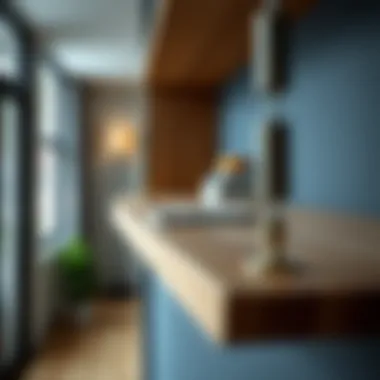
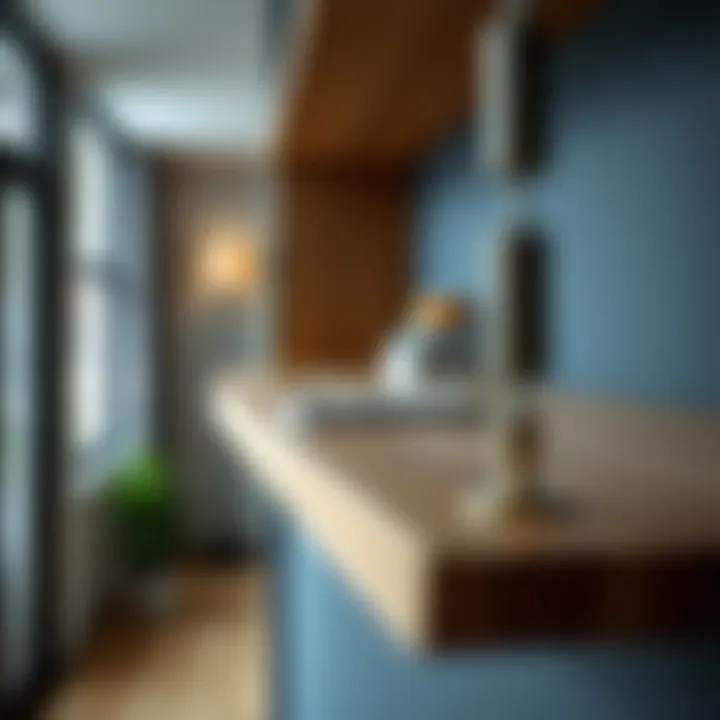
One of the notable advancements in shelf clamp technology is the integration of smart features. Smart shelf clamps are now equipped with sensors and connectivity options that provide significant advantages. For instance, some designs can monitor load limits and stress levels, alerting users if a shelf is overloaded. This proactive approach ensures safety while preserving the integrity of both the shelf and the contents it holds.
Additionally, smart clamps can connect to mobile apps, allowing users to adjust settings remotely or receive notifications. Imagine having shelves that inform you when they are due for maintenance or that can be adjusted for different purposes based on the items being displayed. Not only do these features enhance usability, but they also broaden the scope of design possibilities, making it easier for architects and interior designers to create responsive environments adaptable to various needs.
Furthermore, the technology behind smart shelf clamps emphasizes efficiency and convenience. For commercial settings, such as retail spaces, they enable dynamic display arrangements that can be modified rapidly. Retailers can change their layouts without extensive remodeling. This flexibility is a game-changer in a world where trends shift swiftly and customer preferences are always in flux.
Eco-Friendly and Sustainable Options
As the awareness of environmental issues gains momentum, the demand for eco-friendly and sustainable materials in furniture design is on the rise. This trend significantly impacts shelf clamp manufacturing. Designers and manufacturers are increasingly turning to sustainable options for shelf clamps, recognizing their crucial role in promoting sustainability within the industry.
Materials such as recycled metals and sustainably sourced wood are becoming commonly used in modern shelf clamps. These options not only reduce the carbon footprint associated with furniture production but also appeal to a growing demographic that prioritizes ecological responsibility in their purchasing decisions.
Moreover, innovations extend to the manufacturing processes themselves. Companies are investing in energy-efficient production techniques that minimize waste and utilize renewable energy sources. For instance, 3D printing technology allows for the creation of bespoke shelf clamps with minimal material waste, reflecting a shift towards personalized and sustainable furniture solutions.
Incorporating eco-friendly options into shelf clamp design does not compromise aesthetics. Many manufacturers are opting for natural finishes that highlight the beauty of the materials used while still providing the necessary functionality.
"Fusing sustainability with functionality presents an opportunity for innovative designs that resonate with the values of environmentally conscious consumers."
Essentially, innovations in shelf clamp technology represent a convergence of smart features and sustainable practices, pushing the boundaries of what is possible in furniture design. As these advancements continue to unfold, they promise to redefine our approach to how we use space, making it both more flexible and responsible.
Challenges and Limitations
In the landscape of contemporary furniture design, shelf clamps serve essential roles, yet they also present unique challenges and limitations that designers and users must navigate. Understanding these hurdles not only enhances functionality but also guides decisions regarding aesthetics and practicality. Each challenge has its layers, from compatibility to durability, influencing not just user experience but also the longevity of the furniture itself.
Common Issues Faced by Designers and Users
Compatibility with Various Shelves
Designers often grapple with the compatibility of shelf clamps across different types of shelving materials and designs. The essence of compatibility with various shelves stems from the need for versatility. Not every clamp is designed to accommodate different thicknesses or materials, making it crucial to select the right one. For instance, a clamp that works superbly with particle board might not offer the same benefit when paired with glass shelves.
The key characteristic here is its adaptability. A clamp that boasts wide-ranging compatibility can significantly streamline the design process. This is particularly appreciated in custom furniture projects, where unique dimensions and materials often come into play. One unique feature involves adjustable clamp systems which allow for flexibility, successfully catering to different shelf materials from wood to metal.
However, the challenge lies in ensuring stability while maintaining aesthetic appeal. Designers must consider whether the clamps they choose not only fit the shelves but also look good. Not all clamps are designed to be visually appealing, which can detract from the overall design. Therefore, while compatibility offers advantages, it can also present a dilemma regarding aesthetics versus function.
Longevity and Wear
Longevity and wear are also significant factors that come into play when discussing shelf clamps. This aspect is about how well these clamps can endure the tests of time and the elements. Losely speaking, a clamp that wears out quickly leads to increased maintenance costs and potential safety issues. The crucial feature in this context is the material used in these clamps; higher quality materials often translate to greater durability.
For instance, metal clamps tend to outlast their plastic counterparts when subjected to heavy loads. This makes metal a popular choice among designers who envision long-lasting installations. However, the trade-off can be weight, as metal clamps can sometimes be heavier and more challenging to install.
In addition, designers must weigh the cost versus benefit. While investing in high-quality, durable clamps can be more expensive upfront, they often minimize long-term maintenance needs and contribute to a storehouse of client satisfaction. On the other hand, opting for cheaper alternatives may save money in the short term but can result in frequent replacements and compromised safety. This paradox is pivotal in making sound design decisions, thus emphasizing the necessity of a strong grasp on both longevity and wear in full consideration of overall furniture functionality.
"Choosing the right shelf clamp isn’t just about holding a shelf in place; it’s about ensuring a lasting partnership between form and function."
In summary, the challenges and limitations associated with shelf clamps demand a careful balance between functionality, aesthetics, and durability. The insights gained from understanding issues related to compatibility and wear can greatly influence design choices, ultimately paving the way for more thoughtful, resilient furniture solutions.
Future Trends in Shelf Clamps
As we look ahead, the landscape of furniture design and the role of shelf clamps are poised for noteworthy transformations. These changes are not just passing fads; they represent a fundamental shift in how we approach functionality, aesthetics, and sustainability in our living and working spaces. The future trends in shelf clamps bring forth enhancements that cater to a growing demand for smarter, more adaptable, and environmentally conscious solutions.
Emerging Market Trends
One cannot overlook the powerful influence of technology on the design and functionality of shelf clamps. Smart shelf clamps are beginning to carve their niche, where integration with digital tools can offer real-time feedback about load capacities and structural integrity. Imagine a scenario where a simple app can inform users when adjustments are necessary, ensuring safety and stability at all times. This smart connectivity fosters an environment where users feel more secure and in control of their decor.
Eco-friendliness is another front where shelf clamps are making strides. With increasing awareness about environmental issues, manufacturers are capitalizing on sustainable materials and processes. Bamboo, recycled plastics, and metals are making their way into the production of shelf clamps, aligning with global efforts to reduce carbon footprints.
Furthermore, the customization trend is on the rise. Consumers are no longer satisfied with one-size-fits-all options. Instead, they are looking for products that can seamlessly integrate into their unique spaces. Shelf clamps are evolving to allow more bespoke designs that can cater to individual tastes and requirements. This shift is particularly evident in spaces where the aesthetics must align with functionality; for instance, decorative shelf clamps that use intricate designs or colors while maintaining strength and stability.
These emerging trends reflect broader changes in consumer behavior, emphasizing personalization and responsibility. As architects and interior designers, understanding these currents will be crucial in creating spaces that not only meet functional needs but also resonate with the values of modern users.
"The future belongs to those who believe in the beauty of their dreams." – Eleanor Roosevelt
Ending
In wrapping up the discourse surrounding shelf clamps, it’s essential to highlight their significance in the realm of modern furniture design. As we've explored, these components are not just simple metallic or wooden accessories. They serve several critical roles that go beyond mere support, directly impacting the usability and aesthetic appeal of furniture pieces.
Summarizing Key Insights
- Versatility: Shelf clamps come in various forms, each designed to cater to specific requirements and preferences in diverse settings, be it residential or commercial.
- Aesthetic Enhancement: The trending designs, with an emphasis on minimalism and sleek appearances, show how shelf clamps can contribute positively to the overall look of furniture.
- Best Practices in Installation: Understanding the technical aspects such as load capacity and installation techniques ensures that the clamps perform optimally, supporting safety and functionality.
- Emerging Innovations: The ongoing development of smart shelf clamp technologies and eco-friendly options points to a future where these components align closely with consumers' priorities, such as sustainability and smart home integration.
The harmony between creativity and functionality stems from well-designed and strategically placed shelf clamps. They bridge the gap between style and utility, affirming their status as pivotal elements in modern furniture construction.
The Importance of Shelf Clamps in Furniture Design
The role of shelf clamps transcends their basic function of holding shelves in place. In practical terms, they enable designers to push the boundaries of creativity—creating more open spaces without compromising safety and durability. Their ability to blend seamlessly into various design aesthetics means they can be both utilitarian and decorative, often going unnoticed while playing a crucial role in the structure’s integrity.
After considering all these factors, it is evident that shelf clamps are more than accessories; they are essential tools that enhance the functionality, safety, and beauty of furniture. As such, their thoughtful implementation can elevate design from the ordinary to the extraordinary.



